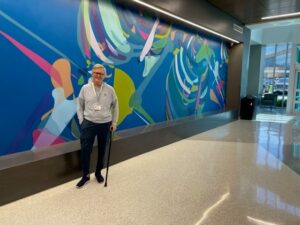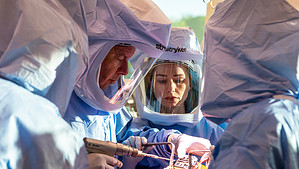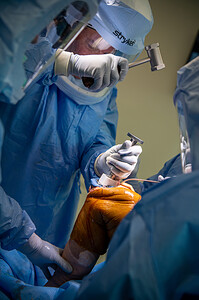View Larger Image

Lowry Barnes, M.D., performs a total knee replacement on his friend and colleague, Tom Frazier, M.D.
Image by Bryan Clifton
UAMS Hand Surgeon Becomes First Surgical Patient at The Orthopaedic & Spine Hospital
| Just two and a half weeks after Thomas Frazier, M.D., underwent a total knee replacement as the first surgical patient at The Orthopaedic & Spine Hospital at the University of Arkansas for Medical Sciences (UAMS), he was back to seeing patients in his orthopaedic clinic.
By the third week, he was performing surgery at the very hospital where he was treated.
The UAMS orthopaedic hand surgeon acknowledged that if he wasn’t able to perform surgery while seated, it probably would have taken another two or three weeks before he was back at the operating table.
Still, the degree of improvement he experienced in such a short time was a testament to the confidence he asserted weeks earlier, when he offered to be the first surgical patient at the new facility.
“Somebody has got to be the first, and I’m doing it just to show I have confidence in the people who built the building, the surgeons, the staff, and everyone involved, down to our sterile processing department,” he said then.
He underwent the hour-long outpatient procedure July 10. It was performed by his friend and colleague of many years, C. Lowry Barnes, M.D., chair of the UAMS Department of Orthopaedic Surgery.
“The process was as smooth as I had anticipated, thanks to the technology in place at the new surgical hospital and the ease of coordinating everything from pre-op to recovery with our dedicated team members,” Barnes said.
Frazier said he began physical therapy the next day and continued going three times a week, under the guidance of Nicholas Hargett, PT, a physical therapist specializing in functional movement assessment at the UAMS Health Orthopaedic Clinic on Autumn Road where Frazier regularly sees patients. The therapy focuses on regaining muscle strength and a good range of motion, and it helped Frazier begin driving again 2½ weeks after the surgery.
“Dr. Frazier showed up ready to work from Day One,” Hargett said. “His motivation to recover was obvious from the start, which allowed him to move quickly through our total knee arthroplasty protocol. We tailored his exercises the way we do for each patient in our clinic, with emphasis on where the patient is lacking in knee extension and knee flexion, or activation of the quadriceps, while incorporating balance work, gait training and lower extremity strength.”
Hargett said recovery from a total knee replacement “is not easy,” but Frazier’s dedication to his home exercise program “and his trust in us as we walk alongside him through the process” enabled him to return to work quickly.
Asked if he learned anything new from a patient’s perspective, Frazier said he was surprised by the amount of pain he experienced, particularly during his first week after surgery. As a result, he said, “I’m a little more sympathetic.”
A nerve block injection he received as part of the Monday morning surgery wore off the following Tuesday afternoon, he said. He said he then had to rely on pain medication, and credited his wife, Cynthia, with ensuring he stayed on a consistent medication schedule. As the pain lessened, he was able to get by on ibuprofen.
Then, “on the seventh day, it was like someone turned a switch, and the pain went away,” Frazier said.

Frazier stands in front of a mural in the new surgical hospital three weeks after his total knee replacement.
Though still feeling muscle soreness from the surgery as he strode around the surgical hospital July 31, assisted only by a cane, he said the joint pain that had plagued him for years was gone, which was an immense relief.
“I feel great!” he said, a big smile on his face.
Since injuring his right knee while playing high school football some 40 years earlier, the pain had gradually worsened to the point that it was interfering with Frazier’s ability to engage in normal activities, including one of his favorite pastimes: golf.
He said that over the years, he underwent two minimally invasive arthroscopies, both performed by his friend and colleague Charles Pearce, M.D., an orthopaedic surgeon at UAMS who specializes in minimally invasive shoulder surgeries and regularly performs minimally invasive knee surgeries. Pearce also underwent a knee replacement performed by Barnes at UAMS in 2019.
Frazier said the arthroscopies helped lessen his pain, but that Pearce told him after the second one that his next option was a total knee replacement, so Frazier knew surgery was on the horizon.
The surgery consisted of removing an arthritic joint and replacing it with one made of metal and plastic. When the entire joint needs to be replaced, as in Frazier’s case, the ends of the thighbone and shinbone are reshaped and the entire joint is resurfaced.
The most common reason for knee replacement is to ease the pain caused by osteoarthritis, a degenerative joint disease that causes the breakdown of joint cartilage and adjacent bone in the knees, making it difficult to walk, climb stairs and get up out of chairs. Severe knee injuries are also common reasons for knee replacements.
Frazier’s surgery was one of 25 to 30 procedures scheduled July 10 in the surgical hospital’s operating rooms. All went off without a hitch.
Again, Frazier said, “My reason for doing it was to let everyone know that I had faith in the system and the people who work here. There weren’t any hiccups, and everybody was upbeat and welcoming, including the operating room staff and nurses.”
He said he anticipated another week of using his cane and perhaps another three weeks of physical therapy.
And then?
“I hope to swing a golf club in six to eight weeks,” he said.



